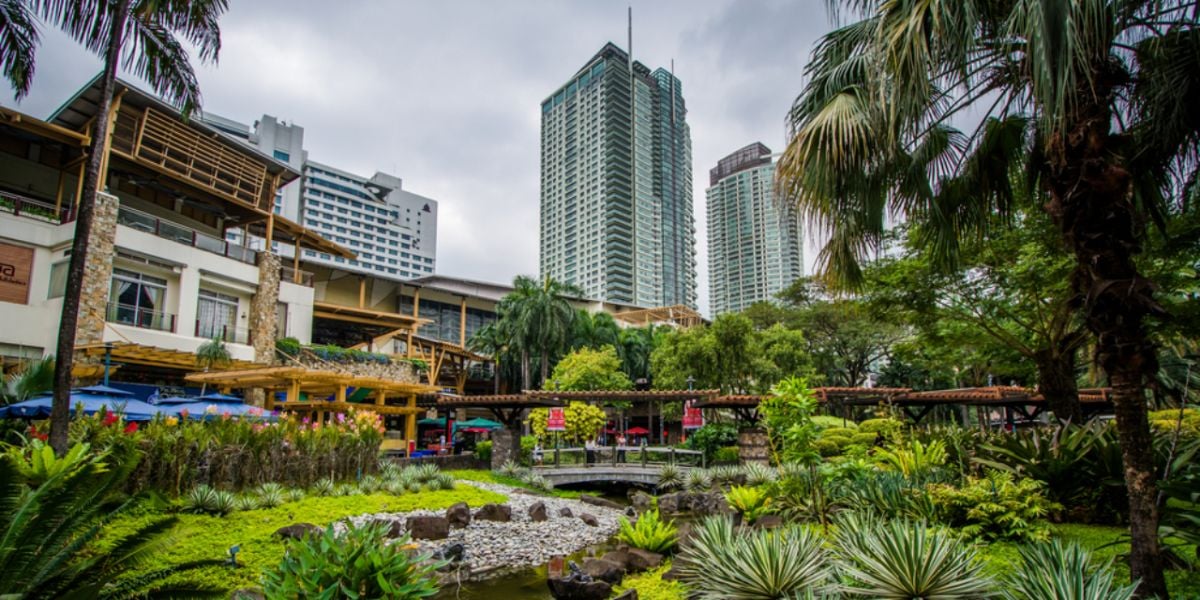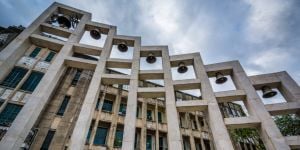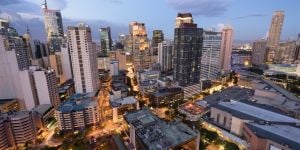
There are lots of renting options to choose from when relocating to Manila. Most expats in the Philippines live in the Metro Manila area, especially in Makati City.
Condo-style (condominium style) living is pretty common in Manila, especially in districts like Eastwood City, Century City, Rockwell Center, and Fort Bonifacio Global City. Everyone is different, but single expats and expat couples normally rent condominium units with one or two bedrooms, while families with children normally prefer one-level houses or two-level apartments with three or more rooms. Finding the right neighborhood in Manila for you is paramount to having a comfortable and enjoyable stay in your adopted city.
The Philippines has progressed and left its shadows at parity with its neighboring Southeast Asian countries. In fact, the economy of the Philippines grew at a rate of 7.6% in 2022, the fastest rate of economic growth recorded by the Philippines since 1976!
If you are considering relocating to the Philippines and are looking at the capital city of Manila, rest assured that this bustling metropolitan is filled with opportunities and various activities. In fact, over the years, large numbers of expatriate families have moved to Manila. Expats have come to Manila to work or have come here to retire. Finding accommodation in Manila will, therefore, be one of your major concerns upon relocating, but fear not; we are here to help!
Popular neighborhoods in Manila
The 2023 population of Manila is approximately 14.7 million, covering a city area of 619.57 km² (239.22 sq mi). Manila is mostly referenced as the metropolitan area, the greater metropolitan area, or Metro Manila.
Manila consists of 16 districts, namely: Binondo, Ermita (which is a tourist area), Intramuros (a fort which was built by the Spanish), Malate (another tourist area), Paco, Pandacan, Port Area, Quiapo, Sampaloc, San Andres, San Miguel, San Nicolas, Santa Ana, Santa Cruz, Santa Mesa and finally Tondo (known for its slums). Like most capital cities in the world, Manila can boast about being the country's economic, cultural, educational, religious, and sports hub; it is an impressive modern city with lots of potential!
The city consists of several neighborhoods, namely Bel Air, Dasmarinas, Magallanes, North and South Forbes, San Lorenzo and Urdaneta, where you are more likely to find individual houses.
There will be plenty of condominiums in Metro Manila, but the following are said to be the top residential areas for expatriates:
Makati City: the number one recommendation if you choose to live in Manila. This is a very central area where you will be close to the working districts, excellent bars and restaurants. It is a very hip and popular area for millennials. Forbes Park is one of the most exclusive areas in Makati. Makati is also home to the Manila Golf and Country Club and the Manila Polo Club.
Bonifacio Global City (BGC): It is a convenient and safe neighborhood with modern infrastructure and a lively community atmosphere. BGC also has excellent shopping malls, top-class hospitals and international schools. Here you will find expats from around the world, whether young professionals or retirees.
Ortigas Center: With an excellent transportation infrastructure like the MRT (Metro Rail Transit) and buses, it is known for being a safer area than others in Manila. Here also, you will find a large expat community.
Alabang Alabang: This area is knowh for its lower cost of living than others and its excellent transportation. It is very close to the heart of the city and ideal for those with a tighter budget.
Quezon City: It offers access to the north (of Luzon) for getaways, excellent train routes, and plenty of trendy restaurants and condominium options.
The rental market in Manila
The leasing cost of various residential options in Manila, such as condo units, bed spaces (shared rooms) and apartments, are strongly driven by the growth and developments in the area rather than the population density in the city. Like most places, condos, bed spaces and apartments have higher rental rates in areas that are within the CBD (Central Business District) or near the business center compared to other locations. The higher rental price can be attributed to the economic activity in the area and the sprouting developments. This includes everything from upscale retail outlets to high-end lifestyle choices. Properties in these locations are driven by the strong demand and the accessibility of their location from various points in the metro.
Accommodation options in Manila
If you are looking at apartments or shared room options in Manila, below is a detailed overview of the common living space characteristics that you might encounter.
Most apartments or even condominiums can be rented out semi-furnished. A fully furnished apartment and condo will be costlier as compared to a semi-furnished one. So, in general, 3 to 4 persons cohabit in the same apartment.
According to research by Statista, the average size of a condo unit in Manila is less than 50 square meters. Moreover, most households resided in a residential unit with a floor area of around 10 to 29 square meters. On the other hand, about 30.2 percent of households occupied a housing unit with a floor area of around 30 to 49 square meters.
Good to know:
Apartments and condos can have one bedroom for smaller units and 3 bedrooms for bigger units.
Limited space can be a common issue for condo units. Renting out can also be tight on the budget, but security guard services and shared amenities like a swimming pool, gym, jogging path and function halls make it an attractive choice.
If renting fully furnished accommodation in Manila, then beds, white goods, a sofa and kitchen table and chairs and a TV will be included. Check the air conditioning units to make sure they are working and modern.
Flat-sharing options in Manila provide shared facilities such as TV, kitchen and refrigerator for all the tenants. Bed spacers usually have to pay for metered utilities like water and electricity.
House hunting in Manila
There are a plethora of real estate companies and realtors in Manila available online. It's recommended that you deal with an established, accredited realtor who you can trust. Here are a few reputable and well-known estate agents and websites that regularly deal with expats:
There are, of course, other ways of looking for accommodation in Manila. For example, word of mouth may snag a bargain rather than incurring realtor fees, but make sure to examine the property, take an inventory of the furniture (if furnished), and get a contract. Ask your company representatives if they can help or your work peers.
It is not advisable to take property or rooms in Manila from the stickers and posters on the signposts. They can be substandard accommodations and can be possible scams also. Therefore, it is best to use an established Realtor as you have more rights, and they will help more than going for it alone!
Rent prices in Manila
The rent price in Manila depends on your choice of accommodation and varies a lot across locations. For example, apartments in Makati usually cost between 35,000 pesos/ USD 635 (studio or one-bedroom unit) to 130,000 pesos/ USD 2,356 (2 to 3 bedrooms). Meanwhile, locations like Manila, Quezon City and Marikina have an average monthly rate of 22,000 pesos/ USD 400, with the lowest rental prices attributed to tenants who are students. Taguig, home to Bonifacio Global City (BGC), has posted the highest average monthly rate as compared to any other location in the metropolis. It usually commands around 35,000 pesos/ USD 635 to 120,000 pesos / USD 2,177 for studio type and one-bedroom units, while two to three-bedroom units cost 50,000 pesos/ USD 907 to 350,000 pesos/ USD 6,350 USD. Ortigas, considered the country's second business district, has a lot of renting options as well, ranging from 25,000 pesos/ USD 453 to 95,000 pesos/ USD 1,723 per month for studio type and one-bedroom apartments, while two-bedroom apartments will range between 35,000 pesos/ USD 635 and 165,000 pesos/ USD 2,993 per month.
Lease conditions in Manila
Note that lease contracts in Manila, as in the rest of the Philippines, generally have a 1-year term, which is renewable. Moreover, you are usually required to pay a deposit, which is generally equal to two months' rent. However, the sum can be negotiated with the owner, even if you go through a real estate agency.
A lease agreement in Manila (and the Philippines) is a contract between the lessor and the lessee which protects both parties; the property owner and the expat. This grants the lessee the right to use a property that belongs to or is managed by the lessor for a predetermined period of time in exchange for recurring rental payments from the lessor. The lease does not grant the lessee any ownership rights.
If a tenant decides to move out, a letter of cancellation must be provided to the landlord one month in advance to give ample time to find new occupants.
The lease agreement/contract will include names of the protagonists, witnesses, terms and conditions, rental rate, tenure, force majure and judicial relief information in the event of an issue. A deposit, valid ID, valid visa, and, at times, your work contract will have to be produced before signing the lease agreement. The lease agreement will also need to be notarized in Manila.
It is strongly advised always to have a lease agreement, even if there is a cheaper option for a deal ‘off the books'. Stay legal, know your rights, and be secure, knowing that you can live comfortably and economically with legal rights under your belt.
Buying property in Manila
Buying property in Manila can be a good investment, and there are more and more condos and apartments being built across Manila. The market is also showing signs of growth post-COVID-19, which is promising for the potential investor. Expats looking to buy property in Manila must have a valid visa. Find out more about visas in our article Visas for the Philippines.
It's worth noting that in the Philippines, an expat can purchase property but not the land on which it is built. Land purchases are 40% ownership for the expat and 60% to a Filipino/a national. Condominium projects are similar to corporations in that 60% should be owned by Filipinos. Although it is clear that foreigners are not allowed to own land in the country, these rules are subject to certain exceptions, such as buying land through a corporation. If you want to explore these options, you would have to obtain local legal advice to help you.
As mentioned above, Bonifacio Global City (BGC), Makati City, Ortigas Center, Alabang Alabang, and Quezon City are popular residential areas for expats and popular for foreign investors also.
Safety in Manila
Most condominiums and gated communities have a 24-hour security guard, so you will not have any issues. This is beneficial for expats in such a big city, but you can still install CCTV if you feel it is needed. Always lock your doors and close your windows when going outside, and only allow people you trust into your home. If you are going abroad for a long period of time, tell only your trusted friends and ask them to keep an eye on the property.
Overall, Manila is an exciting place to live in, but be aware of the recommended areas above, where there is less crime and a better standard of living. Keep an eye on the rental and purchase prices in the market and always get a contract for any property transaction.
We do our best to provide accurate and up to date information. However, if you have noticed any inaccuracies in this article, please let us know in the comments section below.








